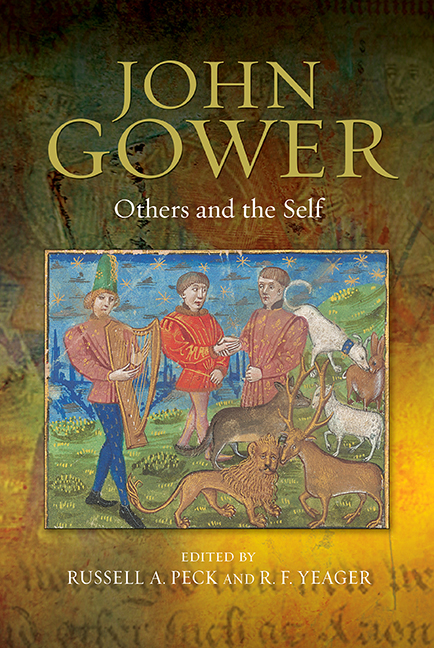Book contents
- Frontmatter
- Contents
- List of Illustrations
- Abbreviations
- Introduction
- PART I KNOWING THE SELF AND OTHERS
- 1 The Materiality of Cognition in Reading, Staging, and Regulation of Brain and Heart Activities in Gower's Confessio Amantis
- 2 The Sound of My Voice: Aurality and Credible Faith in the Vox Clamantis
- 3 “Noght withoute peine”: Chastity, Complaint, and Lucrece's Vox Clamantis
- 4 Reading Faces in Gower and Chaucer
- 5 Gower and Mortality: The Ends of Storytelling
- PART II THE ESSENCE OF STRANGERS
- PART III SOCIAL ETHICS, ETHICAL POETICS
- Bibliography
- Index
- VOLUMES ALREADY PUBLISHED
2 - The Sound of My Voice: Aurality and Credible Faith in the Vox Clamantis
from PART I - KNOWING THE SELF AND OTHERS
Published online by Cambridge University Press: 30 April 2019
- Frontmatter
- Contents
- List of Illustrations
- Abbreviations
- Introduction
- PART I KNOWING THE SELF AND OTHERS
- 1 The Materiality of Cognition in Reading, Staging, and Regulation of Brain and Heart Activities in Gower's Confessio Amantis
- 2 The Sound of My Voice: Aurality and Credible Faith in the Vox Clamantis
- 3 “Noght withoute peine”: Chastity, Complaint, and Lucrece's Vox Clamantis
- 4 Reading Faces in Gower and Chaucer
- 5 Gower and Mortality: The Ends of Storytelling
- PART II THE ESSENCE OF STRANGERS
- PART III SOCIAL ETHICS, ETHICAL POETICS
- Bibliography
- Index
- VOLUMES ALREADY PUBLISHED
Summary
Sound, as Jean-Luc Nancy notes, is an assault. Our senses absorb sound without impediment—unlike the eye, the ear is multidirectional and always open. We can focus on particular sounds at the expense of others, but barring mechanical or artificial apparatuses, we cannot “close our ears” to sound. The act of listening is thus an opening to the presence of sound as it moves through space and time, and, as Nancy writes, “To listen is to enter into that spatiality by which, at the same time, I am penetrated, for it opens up in me as well as around me, and from me as well as toward me.” As a result, he argues, “To be listening is always to be on the edge of meaning.” Yet, of course, to hear is not the same as to listen: in both, the human body interacts with a sonic event, either through production or reception, but the mechanisms by which sound exerts pressure upon the ear are markedly different. In listening, we attend to a sound, be it a speech-act or a soundscape, with intention; listening is a temporal act of subjective engagement. Hearing is not an act; it is compulsory. In hearing, we are passive: provided we are awake and aware of sensation, sound enters into our consciousness without invitation. Listening, on the other hand, is our awareness of the present presence of sound as it unfolds in time, and it works through anticipation and expectation. We anticipate the word that is coming next. We find pleasure in the satisfying conclusion of a melodic turn or in the completion of a couplet. To look, the eye chooses to move from one sight to another, or (alternatively) to close and shut out sight altogether; to hear, the ear is passively waiting for sound to unfold; to listen, sound becomes an element of temporal subjectivity that is open to the other.
As such, to consider how Gower uses sound, and more specifically, how he uses the sound of his voice in the Vox Clamantis, is to question how we attune ourselves to his language and how we attend to the poetics of the text as it unfolds.
- Type
- Chapter
- Information
- John Gower: Others and the Self , pp. 32 - 49Publisher: Boydell & BrewerPrint publication year: 2017



